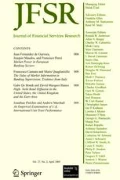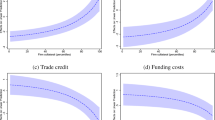Abstract
Is higher bank risk-taking associated with more firm investment? Combining firm- and bank-level data, we examine the relation between bank risk and firm investment in a large sample of firms from nine European countries. We find that bank risk is positively associated with firm investment. Our finding accords with the modern theory of financial intermediation: risk taking by banks enhances firm investment as banks become more willing to perform their key function in the economy. Additionally, we also find that this positive relation is stronger for financially-constrained firms and when banks are more efficient.
Similar content being viewed by others
Change history
19 April 2022
A Correction to this paper has been published: https://doi.org/10.1007/s10693-022-00383-2
Notes
Among many others, the influence of bank governance and regulation (Laeven and Levine 2009; Körner 2017), bank competition (Berger et al. 2009a, b), creditor rights and information sharing (Houston et al. 2010), executive board composition (Berger et al. 2014), culture (Adhikari and Agrawal 2016) have been studied.
Notably, cooperative banks ‒ financial institutions owned by their clients and not listed ‒ have an important market share in several countries of our sample, which can reach up to 60% in France according to the European Association of Cooperative Banks.
For further details see https://ec.europa.eu/eurostat/web/structural-business-statistics/structural-business-statistics/sme.
We also checked whether bank risk has a differential effect on high-tech vs. traditional industries but do not find a clear difference.
References
Abadie A, Imbens GW (2006) Large sample properties of matching estimators for average treatment effects. Econometrica 74(1):235–267
Abadie A, Imbens GW (2011) Bias-corrected matching estimators for average treatment effects. J Bus Econ Stat 29(1):1–11
Abedifar P, Molyneux P, Tarazi A (2013) Risk in Islamic banking. Rev Financ 17:2035–2096
Adhikari B, Agrawal A (2016) Does local religiosity matter for bank risk-taking? J Corp Financ 38:272–293
Adrian T, Brunnermeier M (2016) CoVaR. Am Econ Rev 106(7):1705–1741
Altman EI (2013) Predicting financial distress of companies: revisiting the Z-Score and ZETA® models. In: Handbook of research methods and applications in empirical finance. Edward Elgar Publishing
Altunbas Y, Gambacorta L, Marques-Ibanez D (2010) Bank risk and monetary policy. J Financ Stab 6(3):121–129
Austin PC (2009) Balance diagnostics for comparing the distribution of baseline covariates between treatment groups in propensity-score matched samples. Stat Med 28(25):3083–3107
Berger A, Udell G (1995) Relationship lending and lines of credit in small firm finance. J Bus 68(3):351–381
Berger A, Hasan I, Zhou M (2009a) Bank ownership and efficiency in China: what will happen in the world’s largest nation? J Bank Financ 33:113–130
Berger A, Klapper L, Turk-Ariss R (2009b) Bank competition and financial stability. J Financ Serv Res 21:849–870
Berger A, Kick T, Schaeck K (2014) Executive board composition and bank risk taking. J Corp Financ 28:48–65
Bonfim D, Dai Q, Franco F (2018) The number of bank relationships and borrowing costs: the role of information asymmetries. J Empir Financ 46:191–209
Casey E, O’Toole C (2014) Bank lending constraints, trade credit and alternative financing during the financial crisis: evidence from European SMEs. J Corp Financ 27:173–193
Cihak M, Maechler A, Schaeck K, Stolz S (2010) Who Disciplines Bank Managers? IMF Working Paper n°09/272
Dell’Ariccia G, Detragiache E, Rajan R (2008) The real effect of banking crises. J Financ Intermediat 17(1):89–112
Diamond D (1984) Financial intermediation and delegated monitoring. Rev Econ Stud 51(3):393–414
Erel I, Jang Y, Weisbach M (2015) Do acquisitions relieve target firms’ financial constraints? J Financ 52(1):289–328
Gibson M (1995) Can bank health affect investment? Evidence from Japan. J Bus 68(3):281–308
Ho P, Huang C, Lin C, Yen J (2016) CEO overconfidence and financial crisis: evidence from bank lending and leverage. J Financ Econ 120(1):194–209
Houston J, Lin C, Lin P, Ma Y (2010) Creditor rights, information sharing, and bank risk taking. J Financ Econ 96(3):485–512
Kalemli-Oczan S, Laeven L, Moreno D (2018) Debt overhang, rollover risk, and corporate investment: evidence from the European crisis. NBER Working Paper n°24555
Körner T (2017) Board accountability and risk taking in banking: evidence from a quasi-experiment. J Financ Serv Res 52(3):155–190
Kroszner R, Laeven L, Klingebiel D (2007) Banking crises, financial dependence and growth. J Financ Econ 84:187–228
Laeven L, Levine R (2009) Bank governance, regulation and risk-taking. J Financ Econ 93(2):259–275
Rajan R and L Zingales (1995) What do we know about capital structure? Some evidence from international data. J Finance 50(5):1421–1460
Rubin DB (2001) Using propensity scores to help design observational studies: application to the tobacco litigation. Health Serv Outcomes Res Method 2(3):169–188
Shamshur A, Weill L (2019) Does bank efficiency influence the cost of credit? J Bank Finance 105:62–73
Wurgler J (2000) Financial markets and the allocation of capital. J Financ Econ 58:187–214
Zarutskie R (2006) Evidence on the effects of bank competition on firm borrowing and investment. J Financ Econ 81:503–537
Funding
The authors did not receive support from any organization for the submitted work.
No funding was received to assist with the preparation of this manuscript.
No funding was received for conducting this study.
No funds, grants, or other support was received.
The authors have no relevant financial or non-financial interests to disclose.
All authors certify that they have no affiliations with or involvement in any organization or entity with any financial interest or non-financial interest in the subject matter or materials discussed in this manuscript.
The authors have no financial or proprietary interests in any material discussed in this article.
Author information
Authors and Affiliations
Corresponding author
Ethics declarations
Competing interests
The authors have no competing interests to declare that are relevant to the content of this article.
Additional information
Publisher's Note
Springer Nature remains neutral with regard to jurisdictional claims in published maps and institutional affiliations.
Appendices
Appendix 1
Definition of variables
Variable | Definition |
|---|---|
Gross investment | = (Fixed assets ‒ Lagged fixed assets + Depreciation) / Total assets. Source: Amadeus |
Net investment | = (Fixed assets ‒ Depreciation ‒ Lagged fixed assets ‒ Lagged depreciation)/ (Lagged fixed assets ‒ Lagged depreciation). Source: Amadeus |
Loan loss provisions | = the ratio of Loan loss provisions to Loans. Source: Orbis Bank Focus |
Z-score | = (ROA + CARi) /SD(ROA), where ROA is the return on assets measured by the ratio of net income to total assets, CAR is the ratio of equity capital to assets. SD(ROA) is the standard deviation of ROA over the period of three years (2013- 2015). Source: Orbis Bank Focus |
Bank equity | = the ratio of Bank equity to Bank total assets. Source: Orbis Bank Focus |
Inverse Z-score | = difference between the maximum value for Z-score and Z-score of the bank |
Inverse Bank equity | = difference between the maximum value for Bank equity and Bank equity of the bank |
Ln(Bank total assets) | = the natural logarithm of Bank total assets in million USD. Source: Orbis Bank Focus |
Bank loans/Total assets | = the ratio of Bank loans to Bank total assets. Source: Orbis Bank Focus |
Bank loans/Other earning assets | = the ratio of Bank loans to Other earning assets. Source: Orbis Bank Focus |
Bank ROA | = the ratio of Bank net income to Bank total assets. Source: Orbis Bank Focus |
Bank efficiency | Cost efficiency score. Source: own computation |
Ln(Total assets) | = the natural logarithm of Total assets in million USD. Source: Amadeus |
Cash flow/Total assets | = the ratio of Cash flow to Total assets. Source: Amadeus |
Ln(Number of employees) | = the natural logarithm of the Number of employees. Source: Amadeus |
Sales growth | = (Sales ‒ Lagged sales)/Lagged sales. Source: Amadeus |
Total debt | = (Long-term debt + Short-term debt)/Total assets. Source: Amadeus |
Short-term debt | = the ratio of Short-term debt to Total assets. Source: Amadeus |
Long-term debt | = the ratio of Long-term debt to Total assets. Source: Amadeus |
Tangibility | = Tangible fixed assets scaled by Total assets. Source: Amadeus |
ROA | = EBIT scaled by Total assets. Source: Amadeus |
Value added | = Income taxes + Other taxes + Profit/loss for the period + Staff costs + + Depreciation + Interest payable on loans. Source: Amadeus |
Appendix 2
2.1 Nearest neighbor matching
We employing a matching analysis that allows us to compare the investment of matched firms linked to high and low risk banks. Matching on observable firm characteristics mitigates but does not eliminate concerns related to non-random selection. To implement this methodology, we first assign banks in two groups by their risk level. High risk banks form the treated group (top quartile of banks when risk is measured by Loan loss share and bottom quartile of banks when risk is measured by Z-score and Bank equity) and low risk banks form the control group. We focus on the subsample of one-bank firms for clean identification and combine the exact matching with a nearest neighbor matching algorithm. We find similar pairs of firms linked to banks in different risk groups and then compare their investments.
Specifically, we use the exact matching on country, industry (2-digit NACE) and year and then apply a nearest neighbor matching procedure accounting for a set of firm-specific characteristics. We assume that firm size, cash flow availability and firm growth would be important determinants of firm investment levels.Footnote 5 In addition, a separate specification also accounts for firm age. While accounting for firm age doesn’t change our results, we are reluctant to treat this specification as our main matching specification because the number of firms with available age information is rather low.
Table A1 reports the results of the matching analysis. Panel A shows that the average effect on the treatment group (high risk banks) is about 0.002 when bank risk is measured by Loan loss share, 0.013 for Z-score and 0.002 for Bank’s equity (standard error is 0.000 in all cases). The estimated effect is highly statistically significant and robust across all bank risk measures.
To ensure the quality of matching, distributions of baseline covariates between treatment and control groups in the matched sample need to be assessed (Austin 2009). The covariance balance summary for matched and unmatched samples is reported in Panel B of Table 9 and appears to indicate a good balance. Matching has significantly diminished systematic differences in means and variances. While there is no empirical evidence to support the use of any particular cut-off point to define imbalance, Austin (2009) suggests that a standardized difference greater than 0.10 is indicative of imbalance, while Rubin (2001) suggests a cut-off of 0.25. In our case, the balance is achieved for all covariates as standardized differences are well below the conservative cut-off of 0.1. As balance is not only a property of sample means but also of the overall distribution, we evaluate the variance ratio. Rubin (2001) suggests that covariates are out of balance if the variance ratio is less than 0.5 or greater than 2. Variance ratios for all the covariates in our matched sample are reasonably close to 1. We further assess the balance by checking the kernel density plots —matched data appear to be balanced. These plots are available upon request.
Rights and permissions
About this article
Cite this article
Shamshur, A., Weill, L. Bank Risk and Firm Investment: Evidence from Firm-Level Data. J Financ Serv Res 63, 1–34 (2023). https://doi.org/10.1007/s10693-022-00379-y
Received:
Revised:
Accepted:
Published:
Issue Date:
DOI: https://doi.org/10.1007/s10693-022-00379-y




